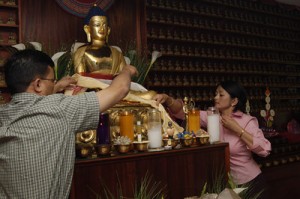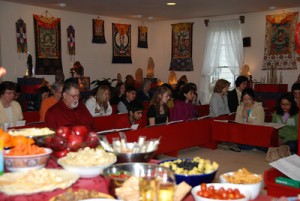
Meaning and Purpose
The basis for offering is the practice of “Generosity.” Generosity helps us to be less self-cherishing and thereby more loving to others. In the Buddhist tradition one makes offerings to the Three Precious Jewels, which are the Buddha, the Dharma, and the Sangha, and the Lama who embodies all three. Offerings are a way of honoring the mind of Enlightenment and the seed potential within all of us to awaken to our true nature. Also one makes offerings with joy and sincere appreciation for the countless blessings one has been given by one’s teachers who by their supreme generosity have given one the Path and a way to end one’s suffering. The practice of offering is another way to acknowledge the boundless love and infinite compassion shown to us by all those who have attained Enlightenment solely for the benefit of sentient beings.
On a deeper level, the practice of offering can be done mentally where one offers everything one sees and experiences such as the beauty of fresh flowers, the wonderful scents in our world like freshly baked bread, the comfort one feels from being warm when it is cold outside, the taste of delicious food, and the happiness we feel when we see a friend we haven’t seen in a while. As we walk through the mall, we can offer everything we see and experience, clothes, furniture, etc. When one is practicing generosity in this way, it is also viewed as a way of renouncing our attachment to these worldly things that are impermanent anyway and only give us temporary happiness. This method of practice if cultivated becomes a potent way of accumulating merit and virtue that can then be offered for the benefit of sentient beings.
What to Offer
Generally, one offers the very best that can be obtained or that one has the means to offer. If the offering is given sincerely from the heart, then even water that is offered becomes a treasure. Flowers, light, incense, perfume or sweet scent, pure water, a conch shell (symbolizes music), and food are traditional offerings. Crystals, jewelry, malas, and money are also suitable offerings.
How to Make the Offering
As a Buddhist, upon entering the shrine room one makes three prostrations towards the altar. Then one arouses the thought of Bodhicitta, which is the sincere wish or motivation to be of benefit to sentient beings by working to achieve enlightenment. The offering is made on the lowest level of the altar or could be placed at the base or foot of the altar. In the case of offering a mala, the mala should be placed on the foot of the image of the Buddha but never around the neck. If offering a BLESSED mala, please note that once offered, the mala can never again be used for personal use. The practice of offering is considered to be a virtuous act, so remember to dedicate the merit and offer it as well for the benefit of all sentient beings.
What Not to Offer
Generally it is best not to offer anything sour or bitter like lemons or limes. Also one would not offer an image of the Buddha such as a statue or a photograph of the Buddha.
When to Make an Offering
Offerings can be made at anytime, however in the Tibetan lunar calendar, there are auspicious days when merit is increased that are traditionally observed by making offerings. For example, the 10th Day or Guru Rinpoche Day, the 25th Day or Dakini Day, 10 Million Days (there are four during the year) which mark different events in the life of Shakyamuni Buddha, and Losar the Tibetan New Year.


